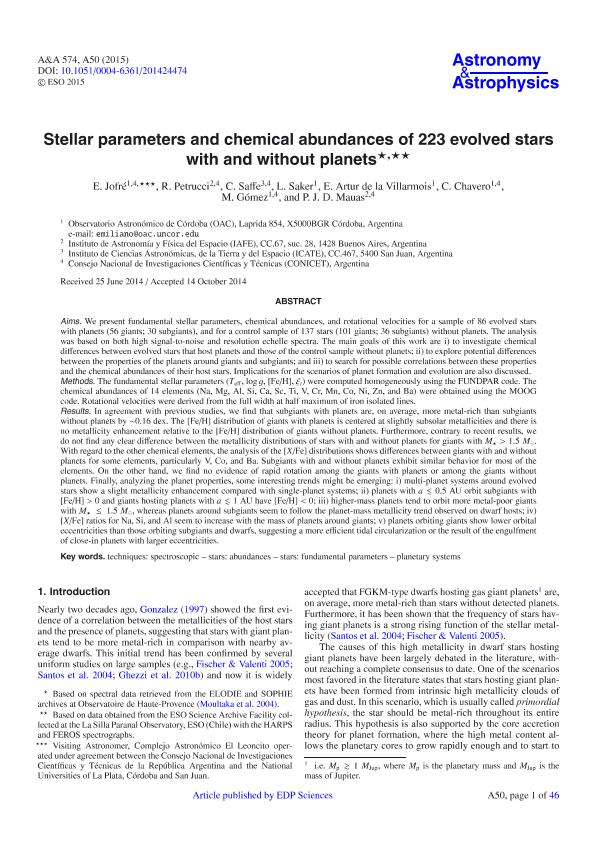Artículo
Stellar parameters and chemical abundances of 223 evolved stars with and without planets
Jofre, Jorge Emiliano ; Petrucci, Romina Paola
; Petrucci, Romina Paola ; Saffe, Carlos
; Saffe, Carlos ; Saker, Leila Yamila
; Saker, Leila Yamila ; Artur de la Villarmois, E.; Chavero, Carolina Andrea
; Artur de la Villarmois, E.; Chavero, Carolina Andrea ; Gomez, Mercedes Nieves
; Gomez, Mercedes Nieves ; Mauas, Pablo Jacobo David
; Mauas, Pablo Jacobo David
 ; Petrucci, Romina Paola
; Petrucci, Romina Paola ; Saffe, Carlos
; Saffe, Carlos ; Saker, Leila Yamila
; Saker, Leila Yamila ; Artur de la Villarmois, E.; Chavero, Carolina Andrea
; Artur de la Villarmois, E.; Chavero, Carolina Andrea ; Gomez, Mercedes Nieves
; Gomez, Mercedes Nieves ; Mauas, Pablo Jacobo David
; Mauas, Pablo Jacobo David
Fecha de publicación:
02/2015
Editorial:
Edp Sciences
Revista:
Astronomy And Astrophysics
ISSN:
0004-6361
Idioma:
Inglés
Tipo de recurso:
Artículo publicado
Clasificación temática:
Resumen
We present fundamental stellar parameters and chemical abundances for a sample of 86 evolved stars with planets and for a control sample of 137 stars without planets. The analysis was based on both high S/N and resolution echelle spectra. The goals of this work are i) to investigate chemical differences between stars with and without planets; ii) to explore potential differences between the properties of the planets around giants and subgiants; and iii) to search for possible correlations between these properties and the chemical abundances of their host stars. In agreement with previous studies, we find that subgiants with planets are, on average, more metal-rich than subgiants without planets by ~ 0.16 dex. The [Fe/H] distribution of giants with planets is centered at slightly subsolar metallicities and there is no metallicity enhancement relative to the [Fe/H] distribution of giants without planets. Furthermore, contrary to recent results, we do not find any clear difference between the metallicity distributions of stars with and without planets for giants with M > 1.5 Msun. With regard to the other chemical elements, the analysis of the [X/Fe] distributions shows differences between giants with and without planets for some elements, particularly V, Co, and Ba. Analyzing the planet properties, some interesting trends might be emerging: i) multi-planet systems around evolved stars show a slight metallicity enhancement compared with single-planet systems; ii) planets with a $lesssim$ 0.5 AU orbit subgiants with [Fe/H] > 0 and giants hosting planets with a $lesssim$ 1 AU have [Fe/H] < 0; iii) higher-mass planets tend to orbit more metal-poor giants with M < 1.5 Msun, whereas planets around subgiants seem to follow the planet-mass metallicity trend observed on dwarf hosts; iv) planets orbiting giants show lower orbital eccentricities than those orbiting subgiants and dwarfs.
Archivos asociados
Licencia
Identificadores
Colecciones
Articulos(CCT - CORDOBA)
Articulos de CTRO.CIENTIFICO TECNOL.CONICET - CORDOBA
Articulos de CTRO.CIENTIFICO TECNOL.CONICET - CORDOBA
Articulos(IAFE)
Articulos de INST.DE ASTRONOMIA Y FISICA DEL ESPACIO(I)
Articulos de INST.DE ASTRONOMIA Y FISICA DEL ESPACIO(I)
Articulos(ICATE)
Articulos de INST.D/CS ASTRONOMICAS D/LA TIERRA Y DEL ESPACIO
Articulos de INST.D/CS ASTRONOMICAS D/LA TIERRA Y DEL ESPACIO
Citación
Jofre, Jorge Emiliano; Petrucci, Romina Paola; Saffe, Carlos; Saker, Leila Yamila; Artur de la Villarmois, E.; et al.; Stellar parameters and chemical abundances of 223 evolved stars with and without planets; Edp Sciences; Astronomy And Astrophysics; 574; A50; 2-2015; 50-96
Compartir
Altmétricas



